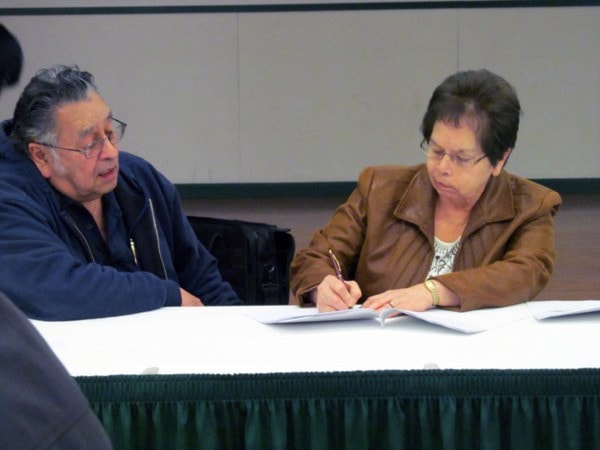The K’ómoks First Nation inked an agreement Friday with the Xwémalhkwu (Homalco) First Nation that defines the rights and responsibilities of each regarding their historical shared access to resources.A signing ceremony at the K’ómoks Band Hall officially recognizes that both groups “are willing to continue to share certain geographic areas,” according to the shared resource harvest area agreement.The agreement covers the harvesting of fish (including shellfish), wildlife and migratory birds as well as gathering plants, medicines and other materials.“The agreement really recognizes the roots of your nations and how they were intertwined in the past,” K’ómoks assistant treaty co-ordinator Ron Frank told a crowd of K’ómoks and Homalco people.“It really takes us back to those roots where we shared the areas where we harvested our resources,” added Frank, who noted that as a member of neither nation, he was proud of both of them for reaching the agreement.“In a modern-day context, this agreement gives us certainty around negotiating our respective treaties,” Frank continued. “We have a very clear agreement that won’t get in the way of each other’s treaty processes.“And in those areas where we share lands and resources — access to lands and resources, it’s very clear that we have to speak to one another before we make decisions that affect those areas.”For instance, the K’ómoks will select treaty settlement lands within their statement of intent area only if they are outside Homalco core areas. Any treaty settlement lands selected by either that are within the other’s core areas will require written consent from the other band.Specifically, K’ómoks recognizes the exclusive right of Homalco to harvest surplus salmon from Bute Inlet. Homalco recognizes the K’ómoks right to do the same from the Courtenay, Puntledge, Browns, Tsolum, Oyster and Salmon rivers.“Instead of each nation only harvesting in your individual nation’s territories … there’s now an agreement whereby you may share harvesting areas,” Frank added. “So it expands your access to resources, provides your families with some security and moves us into the future.”“I really look forward moving into the future supporting each other’s treaty processes,” responded Coun. Maryann Enevoldsen, who joined fellow Homalco councillor and treaty co-ordinator Darren Blaney to the signing ceremony.“I’d also like to thank BCTC (BC Treaty Commission),” noted Enevoldsen. “Without their funding contributions, this agreement wouldn’t have been possible. After many years of working on this agreement, I’m very grateful we were able to accomplish this agreement between nations.”On behalf of Chief Ernie Hardy, who was ill, Couns. Stewart Hardy and Barb Mitchell signed the deal on behalf of the K’ómoks. Enevoldsen and Blaney did likewise for the Homalco.• • •The Homalco First Nation traditionally has lived at Bute Inlet near the upper Sunshine Coast.Its main community and band office is just south of Campbell River, although it has 12 reserves on 686.9 hectares. The band has almost 500 members, about half living on its main reserve.They are negotiating an agreement in principle, the crucial fourth of six stages in the BC Treaty Commission process.The K’ómoks First Nation has 277 members. Almost 120 members and numerous non-members live on the KFN Indian Reserve No. 1 on Comox Road between Courtenay and Comox.This year, K'ómoks members approved an agreement in principle. A formal signing ceremony involving Vancouver Island North MLA/Indian Affairs Minister John Duncan and Aboriginal Relations and Reconciliation Minister Mary Polak has been scheduled for March 24 at the K'ómoks Band Hall.The AIP offers the K'ómoks people $17.5 million and about 5,000 acres of land, including the return of the tip of Goose Spit. It also includes about 2,000 acres at the Royston woodlot, and land at Williams Beach, Kelsey Bay, the base of Mount Washington and Lot BL7 near Union Bay.Stage Five is final agreement negotiations and Stage Six is implementation.editor@comoxvalleyrecord.com
